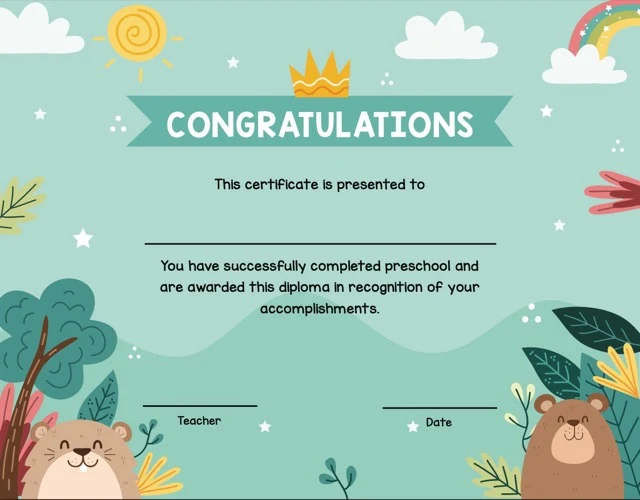Graduation Certificates: Significance and Applications
This briefing document summarizes information from three sources on graduation certificates. Key themes covered include the significance of certificates as proof of achievement and motivational tools, their various forms and components depending on educational level, practical applications like job applications, ceremonial presentation at graduations, and design variations across different educational stages. Important facts highlighted are the specific type of certificate called a diploma, the process for replacing lost certificates, and the importance of signatures for validation. The document also suggests areas for further research, including the evolving societal role of certificates and the psychological effects of receiving them.
Graduation Certificates: A Comprehensive Guide
Briefing Doc: Graduation Certificates
This briefing document reviews the main themes and important facts regarding graduation certificates, drawing on three sources: "Graduation Certificate Examination Study Guide," "Graduation Certificates: A Comprehensive Guide," and "Testing Theme: Graduation Certificates.pdf."
Key Themes:
1.
Significance of Graduation Certificates: Graduation certificates are important because they provide formal recognition of academic achievement, instill a sense of accomplishment in graduates, offer tangible proof of education, serve as motivational tools, and act as keepsakes. ("Graduation Certificate Examination Study Guide")
2.
Types and Components: Graduation certificates come in various forms, tailored to the specific level of education, from preschool to graduate school. They typically include the issuing institution's name, the recipient's name, the date of graduation, the degree/program completed, and official signatures. ("Graduation Certificates: A Comprehensive Guide")
3.
Practical Uses: Certificates can be displayed as achievements, included in job applications, and utilized for further education. ("Graduation Certificate Examination Study Guide")
4.
Ceremonial Presentation: Certificates are typically presented during formal graduation ceremonies involving calling graduates' names, a stage walk, a commencement speaker, and celebrations with loved ones. ("Graduation Certificates: A Comprehensive Guide")
5.
Design Variation: "Testing Theme: Graduation Certificates.pdf" visually demonstrates the diversity of certificate designs. Preschool/kindergarten certificates often feature bright colors and whimsical designs, while high school and college diplomas are more formal. ("Graduation Certificate Examination Study Guide")
Important Facts:
●
Diplomas are a specific type of graduation certificate awarded for completing high school or higher education programs. ("Graduation Certificate Examination Study Guide")
●
Lost or damaged certificates can be replaced by contacting the issuing institution. ("Graduation Certificates: A Comprehensive Guide")
●
Signatures on certificates validate authenticity and officially acknowledge student achievement. ("Graduation Certificate Examination Study Guide")
Quotes:
●
"Graduation certificates are important because they provide formal recognition of achievement, instill a sense of accomplishment, offer tangible proof of education, serve as motivational tools, and act as keepsakes." ("Graduation Certificate Examination Study Guide")
●
"A graduation certificate is an official document that recognizes and celebrates a student's successful completion of a course of study or educational program." ("Graduation Certificates: A Comprehensive Guide")
Further Considerations:
The sources also suggest further exploration of the evolving role of graduation certificates in modern society, the psychological impact of receiving them, arguments for and against standardization, and the historical and cultural significance of graduation ceremonies.
Graduation Certificates: A Comprehensive Guide
Frequently Asked Questions about Graduation Certificates
1. What is a graduation certificate?
A graduation certificate is an official document that recognizes and celebrates a student's successful completion of a course of study or educational program.
2. Who typically receives graduation certificates?
Graduation certificates are commonly awarded to students of all ages, ranging from preschool to graduate school. They can mark the culmination of a variety of educational experiences, including:
●
Preschool or kindergarten graduation
●
Completion of elementary or middle school
●
High school graduation
●
College or university degree programs
●
Vocational or technical training programs
3. What information is typically included on a graduation certificate?
Graduation certificates usually include the following information:
●
Name of the issuing institution: This could be a school, college, university, or training center.
●
Name of the recipient: The full name of the student who has graduated.
●
Date of graduation: The specific date on which the student completed their studies.
●
Degree or program completed: The name of the degree, diploma, or certificate earned.
●
Signatures: Often, the certificate will bear the signatures of school officials, such as the principal, superintendent, or university president.
4. What are the different types of graduation certificates?
Graduation certificates come in various forms, often tailored to the specific level of education or program. Some common types include:
●
Preschool/Kindergarten Certificates: These certificates are often brightly colored and feature whimsical designs to celebrate a child's early educational milestone.
●
Elementary/Middle School Certificates: These certificates may be more formal, recognizing a student's progress through primary education.
●
High School Diplomas: High school diplomas are official documents signifying the completion of secondary education.
●
College/University Diplomas: These diplomas are awarded upon the completion of a bachelor's, master's, or doctoral degree program.
●
Vocational/Technical Certificates: These certificates document the successful completion of a specialized training program in a particular trade or skill.
5. Why are graduation certificates important?
Graduation certificates hold significance for several reasons:
●
Formal Recognition: They serve as formal acknowledgment of a student's academic achievements and hard work.
●
Sense of Accomplishment: Receiving a certificate can instill a sense of pride and accomplishment in the graduate.
●
Tangible Proof of Education: Certificates provide tangible evidence of educational qualifications, essential for employment and further education.
●
Motivational Tool: They can motivate students to persevere in their studies and strive for academic success.
●
Keepsake and Memory: Graduation certificates often become cherished keepsakes, marking a significant life event.
6. How are graduation certificates presented?
Graduation certificates are typically presented during a formal graduation ceremony. The presentation may involve:
●
Calling each graduate's name
●
Having graduates walk across a stage to receive their certificates
●
A commencement speaker addressing the graduates
●
Celebrating with family and friends
7. What can you do with a graduation certificate?
Graduation certificates serve various practical purposes:
●
Displaying Achievement: Proudly display your certificate at home or in your office.
●
Job Applications: Include it as proof of your education when applying for jobs.
●
Further Education: Use it to apply for higher education programs or professional certifications.
●
Personal Records: Keep it as part of your important personal documents.
8. Can graduation certificates be replaced if lost or damaged?
If a graduation certificate is lost or damaged, it's usually possible to obtain a replacement. Contact the issuing institution for information on their replacement process.
Graduation Certificate Examination Study Guide
Graduation Certificate Examination Study Guide
Short Answer Questions
Instructions: Answer the following questions in 2-3 sentences each.
1.
What are the five main reasons why graduation certificates are important?
2.
List five types of information typically included on a graduation certificate.
3.
Describe three ways graduation certificates can be used practically.
4.
What is the main purpose of a graduation certificate?
5.
Differentiate between a high school diploma and a college/university diploma.
6.
Explain how the design of a preschool/kindergarten graduation certificate might differ from a high school diploma.
7.
What should you do if you lose or damage your graduation certificate?
8.
Who are the typical recipients of graduation certificates?
9.
Briefly explain the significance of signatures on a graduation certificate.
10.
Describe a typical graduation ceremony where certificates are presented.
Short Answer Key
1.
Graduation certificates are important because they provide formal recognition of achievement, instill a sense of accomplishment, offer tangible proof of education, serve as motivational tools, and act as keepsakes.
2.
Graduation certificates typically include: the name of the issuing institution, the recipient's name, the date of graduation, the degree/program completed, and signatures of officials.
3.
You can use your graduation certificate for displaying your achievement, including it in job applications, and utilizing it for further education applications.
4.
The main purpose of a graduation certificate is to officially recognize and celebrate a student's successful completion of a course of study or educational program.
5.
A high school diploma signifies completion of secondary education, while a college/university diploma is awarded for completing a bachelor's, master's, or doctoral degree program.
6.
Preschool/kindergarten certificates often feature bright colors and whimsical designs, whereas high school diplomas are more formal and serious in design.
7.
If you lose or damage your certificate, contact the issuing institution to inquire about their replacement process.
8.
Students of all ages, from preschool to graduate school, typically receive graduation certificates for completing various educational programs.
9.
Signatures on a graduation certificate, usually from school officials, validate the authenticity of the document and officially acknowledge the student's achievement.
10.
A typical graduation ceremony involves calling each graduate's name, having them walk across a stage to receive their certificates, often includes a commencement speaker, and is a time of celebration with family and friends.
Essay Questions
Instructions: Answer the following questions in essay format, providing in-depth explanations and examples where applicable.
1.
Analyze the evolving role of graduation certificates in modern society, considering factors such as technological advancements, changing job market demands, and societal perceptions of education.
2.
Discuss the psychological and emotional impact of receiving a graduation certificate on individuals, exploring the sense of accomplishment, motivation for future endeavors, and personal growth it can foster.
3.
Critically evaluate the arguments for and against standardizing graduation certificates across different educational levels and institutions. Consider the implications for recognizing diverse learning experiences and the potential impact on employers and higher education institutions.
4.
Explore the historical and cultural significance of graduation ceremonies and the presentation of certificates. Analyze how these traditions have evolved and adapted to contemporary society while maintaining their symbolic value.
5.
Imagine you are tasked with designing a graduation certificate for a new, innovative educational program. Detail the key elements you would include and explain how your design would effectively represent the program's values and the achievements of its graduates.
Glossary of Key Terms
●
Graduation Certificate: An official document acknowledging the successful completion of an educational program.
●
Issuing Institution: The school, college, university, or training center conferring the graduation certificate.
●
Recipient: The student who has graduated and receives the certificate.
●
Diploma: A specific type of graduation certificate awarded for completing a high school or higher education program.
●
Commencement Ceremony: A formal event where graduation certificates are presented to students.
●
Tangible Proof of Education: Physical evidence of educational qualifications, vital for employment and further studies.
●
Keepsake: A cherished object kept as a reminder of a special event or time period.
●
Vocational/Technical Certificate: A certificate documenting the completion of a specialized training program in a trade or skill.
●
Replacement Process: The procedure for obtaining a new copy of a lost or damaged graduation certificate.
●
Academic Achievement: Successful accomplishment of educational goals and standards.
























